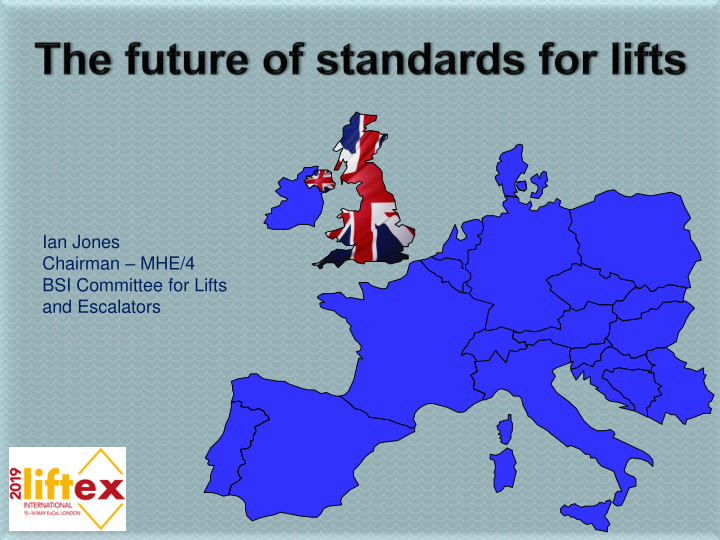



Ian Jones Chairman – MHE/4 BSI Committee for Lifts and Escalators
Regardless of what eventually happens with Brexit, the UK has not left the European continent. BSI has entered into a partnership deal with CEN, meaning that BSI will continue to actively participate in the creation and publication of CEN/CENELEC Standards.
✓ This means that the UK lift industry will continue to use the same EN and ISO standards as used by the rest of Europe. ✓ In the event of Brexit the only difference will be that “Harmonised Standards” become “Designated Standards”, but their content will be identical. ✓ This ensures the there is no divergence between the UK industry and that of Europe on safety or technical requirements.
Due to some legal reasons the European Commission has taken the decision not to award Harmonised Status to the last revisions of EN 81- 21, 28, 58, 71, 72 and 77. This means that legally they cannot be used to show compliance with the Lifts Directive and that Design Examination would be needed from a Notified Body.
The answer to this legal uncertainty is for manufacturers to build lifts to the latest version of these standards but to declare conformity to the old version, since the new versions incorporate all of the requirements of the old. However this will be extremely confusing to those specifying and purchasing new lifts.
In the short term these standards may need small revisions to align their references to EN 81- 20:2019. In the long term they may need to be split into two parts: Part A – Containing only the requirements of the directive concerning the delivered product. No informative annex’s, no builders requirements, no mention of responsible persons. Part B – Containing everything taken out of part A, which would then become a non-harmonised EN standard.
In March the ISO 8100-1, 8100- 2 and 8100-3 lifts were published for the first time. Parts 1 and 2 are technically identical to EN 81-20 and 50. These are the first world wide prescriptive standards for lifts
The future plan is to re-publish and re-number all ISO standards for lifts under the ISO 8100 numbering system. Series N° Title (element 1) 8100 Lifts for the transport of persons and goods 8101 Fire safety on lifts (evacualtion) 8102 Electrical requirements for lifts, escalators and moving walks 8103 Escalators and moving walks 8104 Improvement of safety on existing lifts & escalators 8105 Other lifting appliances or equipment
Table 2 — Parts of the series of ISO 8100 to ISO 8105 standards, elements of their titles and numbers Title Reference number of the Remarks Element 1 Element 2 standard Description of the requirements for complete Part 1 : Safety requirements for passenger or goods passenger lifts installations ISO 8100 – 1 passenger and goods independent from the driving system. In the process passenger lifts of adoption of European Standard EN 81-20. Description of the examinations, calculations and Part 2 : Design rules, calculations, tests of lift components used in any type of lift ISO 8100 – 2 examinations and tests of lift (passenger-, goods passenger-, goods only lifts, etc.). components In the process of adoption of European standard EN 81-50 Part 3 : Regional differences (North In the process of adoption of European standards EN America & Japan) for 81-20 and EN 81-50. This document shows the ISO/TR 8100 – 3 passenger and goods differences of safety requirements between EN 81 Lifts for the passenger lifts (elevators) standards and A17/B44 and JIS standards for lifts transport of persons and ISO 8100 – 4 Part 4 : Firefighters lifts Future deliverable goods Description of alternative solutions where ISO 8100 – 5 Part 5 : New lifts in existing buildings requirements of ISO 8100-1/2 cannot be fulfilled due to building structural constraints. Future deliverable Part 6 : Remote alarm for passengers ISO 8100 – 6 Future deliverable and goods passenger lifts It will correspond to current ISO 4190-5, which will be ISO 8100 – 7 Part 7 : Disability referenced according to this table when revised. Part 8 : Specific requirements for lifts in It corresponds to current ISO 8383, which will be ISO 8100 – 8 ship referenced according to this table when revised. ISO 8100 – 9 Part 9 : Kept free "To be continued"
At present CEN is working on the next full revision of EN 81-20 and 50. This is a technical revision and will include such items as alternative means of suspension, changes to PESSRAL, etc. This work will now be transferred to the revision of the ISO 8100-1 / 2 standards, but under CEN lead, meaning CEN will still be responsible for the work.
prEN 81-20:2019 + prEN 81-50:2019 (Draft revision of Comments from EN 81-20/50) DIS/FDIS process ISO 8100-1 ISO 8100-1:2022 + + ISO 8100-2 ISO 8100-2:2022 CEN and ISO approval processes applied in parallel ISO 8100-1:2019 EN ISO 8100-1:2022 + + ISO 8100-2:2019 EN ISO 8100-2:2022
When completed it will be published as EN ISO 8100-1 / 2 and the CEN standards EN 81-20 / 50 will be withdrawn.
Recommend
More recommend